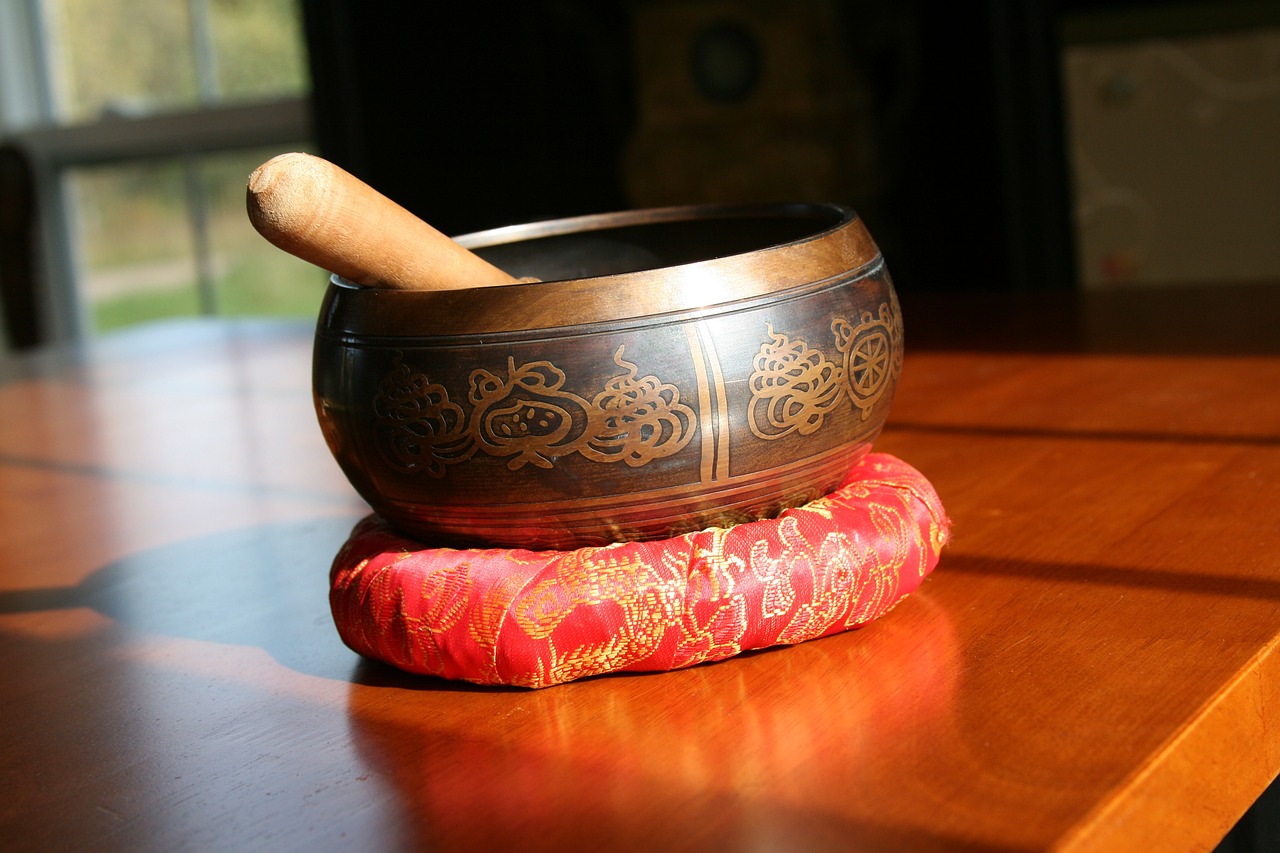If you’re delving into the world of sound healing or meditation, you may come across two commonly used terms: Tibetan bowls and singing bowl. These terms often get used interchangeably, but they do have subtle differences based on origin, materials, and sound properties.
In this blog, we’ll discuss the main difference between a Tibetan bowl and a singing bowl. I’ll clarify the differences between Tibetan bowls, which are a type of singing bowl, and the broader category of singing bowls, including crystal varieties. By the end, you’ll have a better understanding of these unique instruments and their respective uses in healing and meditation.
What are Tibetan Bowls?
Tibetan bowls, also referred to as Himalayan or metal singing bowls, have a rich history and are traditionally made from a combination of metals like copper, tin, zinc, and sometimes silver or gold. These bowls have been handcrafted for centuries and are often used in spiritual practices such as meditation, healing rituals, and prayer in the Himalayan regions, including Tibet, Nepal, and Bhutan.
Tibetan bowls are known for their complex harmonic tones. Each bowl can produce multiple overtones, which gives it a rich and intricate sound. Depending on the size, a Tibetan bowl may produce two or three frequencies, which can create a more immersive experience.
Larger bowls can generate deeper tones, while smaller ones produce higher pitches. The diverse sound spectrum of these bowls ranges from the mid-first octave to the sixth or even seventh octave, providing a range of therapeutic and meditative benefits.
What are Singing Bowls?
The term “singing bowl” is a broader category that includes different types of sound-producing bowls, such as Tibetan metal bowls and crystal singing bowls. Singing bowls produce sound when struck or played with a mallet, creating vibrations that produce rich harmonics and overtones. These sounds are often used in sound therapy, meditation, and yoga practices.
Among the types of singing bowls, crystal singing bowls are distinct from Tibetan bowls in several key ways. Crystal bowls are made of pure quartz crystal silica sand, heated to high temperatures, and molded into a bowl shape.
These bowls were first created in the late 1960s and became popular for sound healing practices in the 1990s. Unlike Tibetan bowls, crystal singing bowls produce a single frequency, often described as a “pure tone.” This single tone has less complexity but is highly focused, which makes it suitable for targeted therapeutic practices.
Comparison Table: Tibetan Bowl Vs Singing Bowl
Here’s a concise table summarizing the differences between Tibetan bowls and crystal singing bowls:
| Feature | Tibetan Bowl | Crystal Singing Bowl |
| Material | Metal alloy (usually 7 metals) | Pure quartz crystal |
| Sound Complexity | Rich, layered overtones | Single, pure tone |
| Historical Origin | Himalayan region, centuries old | Modern origin (1960s) |
| Tone | Multiple frequencies, complex | Focused, single dominant frequency |
| Therapeutic Uses | Deep relaxation, meditation, pain relief | Chakra balancing, group meditation, energy clearing |
| Durability | Durable, hand-hammered | Fragile, requires careful handling |
| Volume | Moderate, subtle | Loud, powerful |
| Best For | Personal meditation, sound therapy | Group sound baths, energy work |
Materials and Manufacturing Differences
The materials used to make Tibetan and crystal singing bowls greatly influence their sound, durability, and intended uses.
- Tibetan Bowls: Traditionally crafted from a blend of seven metals (copper, tin, zinc, iron, and sometimes traces of precious metals), Tibetan bowls are hand-hammered into shape, giving each bowl a unique design and tonal quality. The combination of metals allows Tibetan bowls to produce complex overtones, which makes them suitable for creating intricate soundscapes.
- Crystal Singing Bowls: These bowls are typically made from pure quartz crystal, sometimes infused with other crystals such as rose quartz or amethyst. The high purity of the quartz results in a distinct and resonant sound, but these bowls are also more fragile compared to metal bowls. The manufacturing process involves heating quartz to temperatures over 2000°F and shaping it into a bowl, which results in a cleaner and more focused tone. Crystal singing bowls are often used in environments where a more intense, louder sound is desired, such as group meditation or sound baths.
Sound Characteristics
One of the most significant differences between Tibetan and crystal singing bowls is the sound each produces.
- Tibetan Bowls produce complex, layered harmonics that include fundamental tones and overtones. This means that when struck or played, a Tibetan bowl can generate multiple notes simultaneously, creating a richly textured sound. The ability of Tibetan bowls to produce binaural beats and multiple layers of sound is one reason why they are used in deep meditative practices and for inducing relaxation. The vibrational frequencies of Tibetan bowls are also known for their healing properties, helping balance the body’s energy and stimulate relaxation at a cellular level.
- Crystal Singing Bowls, on the other hand, produce a purer tone with a single dominant frequency, often with an octave harmonic. While they do not produce the same level of harmonic complexity as Tibetan bowls, the pure tone of crystal singing bowls is often perceived as more direct and powerful. This focused sound can have a laser-like effect, which some believe is beneficial for addressing specific emotional or physical imbalances.
Applications in Healing and Meditation
Both Tibetan and crystal singing bowls are used in sound therapy and meditation, but their unique sound properties make them suitable for different purposes.
Tibetan Singing Bowls:
Due to their rich and layered overtones, Tibetan bowls are effective for creating a state of deep relaxation and meditative immersion. The complex sound waves entrain brainwaves, moving from active Beta states to more relaxed Alpha and Theta states, which facilitates deep meditation and relaxation.
The vibrations from Tibetan bowls are also said to promote healing by reducing stress and improving energy flow throughout the body. Tibetan bowls are typically used in personal meditation, sound healing sessions, and even for “sonic massages,” where the bowl’s vibrations are used to massage the body.
Crystal Singing Bowls:
The intense, clear sound of crystal bowls is ideal for environments where sound projection is essential, such as large group meditations, yoga classes, or sound baths. Because quartz crystal is believed to carry a unique vibrational frequency, the sound produced by crystal bowls is often used for chakra balancing and energy clearing. Their high volume and pure tones make them effective for working with larger spaces or amplifying healing intentions.
Historical and Cultural Significance
- Tibetan Bowls have a deep cultural and historical background, originating from the Himalayan regions and used for centuries in Tibetan Buddhist practices. These bowls are often seen as spiritual instruments, used by monks for meditation and ceremonial purposes.
- Crystal Singing Bowls, in contrast, have a more modern origin, first emerging in the late 20th century as a byproduct of advancements in electronics manufacturing. Their cultural significance is largely tied to the New Age movement, where they are associated with spiritual practices focused on healing and energy work.
Differences in Usage Techniques
The way these bowls are played also contributes to their unique characteristics.
- Tibetan Bowls: Typically played using a wooden, felt, or leather-wrapped mallet, the playing technique involves either striking or running the mallet along the rim in a circular motion. Different mallets produce different tonal qualities—wooden mallets create a sharp, clear tone, while felt mallets offer a softer, more ethereal sound. Tibetan bowls are versatile, allowing for varied playing styles that produce a range of sound effects, such as overtones and harmonics, which enhance meditation and therapeutic sessions.
- Crystal Singing Bowls: Crystal bowls are usually played using a rubber or silicone mallet. Because they produce a single dominant frequency, the playing technique is generally simpler, focusing on creating a sustained tone. The intensity of the sound can be controlled by varying the pressure applied while running the mallet around the rim, and this sustained, focused sound makes crystal bowls particularly powerful for chakra work and energy healing.
Choosing Between Tibetan and Crystal Singing Bowls
The decision to use a Tibetan or crystal singing bowl largely depends on the context of the intended use.
- For Deep Meditation and Personal Use: Tibetan singing bowls are ideal for individuals looking for a more nuanced, layered sound experience. Their complex overtones make them well-suited for personal meditation, stress relief, and holistic healing.
- For Group Meditation and Sound Baths: Crystal singing bowls, with their louder, purer tones, are often chosen for group settings where sound needs to carry. Their intensity and directness make them effective for creating powerful energy shifts and for use in larger spaces.
Both types of bowls offer unique benefits and can be powerful tools for enhancing meditation and promoting healing. Whether you choose a Tibetan bowl for its cultural richness and complex harmonics or a crystal bowl for its focused, powerful tones, both can serve as valuable companions in your journey toward well-being and inner peace.
Exploring the Therapeutic Benefits of Tibetan and Crystal Singing Bowls
Both Tibetan and crystal singing bowls are celebrated for their therapeutic benefits, but they have unique attributes that make them effective in different aspects of healing. These bowls have gained recognition in sound therapy, meditation, and spiritual practices for their ability to induce relaxation, enhance energy flow, and aid in emotional and physical healing.
1. Healing Vibrations and Cellular Stimulation:
Tibetan singing bowls, with their complex overtones, are especially effective for balancing the body’s energy and stimulating healing at a cellular level. The harmonics produced by these bowls have been found to create a “Frequency Following Response” in the brain, leading to a shift from Beta to Alpha, Theta, and even Delta brainwave states.
This deep state of relaxation helps reduce anxiety, improve mood, and increase a sense of spiritual well-being. The vibrations from Tibetan bowls have been described as a form of “sonic massage,” resonating deeply within the body and promoting physical and mental relaxation.
Many sound therapists use Tibetan bowls to target specific areas of the body for localized pain relief, helping with conditions like headaches, muscle tension, and stress-related ailments.
2. Chakra Balancing and Energy Clearing:
Crystal singing bowls are particularly popular for chakra balancing and energy clearing. The pure, focused tone of crystal bowls resonates strongly with the body’s energy centers, or chakras, and is used to release blockages and restore energetic harmony.
Each crystal bowl is often tuned to a specific musical note, which corresponds to a particular chakra. For example, a bowl tuned to the note “C” is commonly associated with the root chakra, helping to ground and stabilize one’s energy.
The loud, penetrating sound of crystal singing bowls is highly effective in environments where a strong auditory impact is needed, such as sound baths, where participants experience the vibrations collectively.
3. Mental Clarity and Emotional Release:
One of the key differences between Tibetan and crystal singing bowls lies in the impact they have on the mental and emotional states of the listener. Tibetan bowls, with their multifaceted sound, can create a calming and introspective atmosphere that encourages a deeper connection with one’s thoughts and emotions.
Their ability to produce binaural beats and layered harmonics can foster a sense of inner exploration, aiding in emotional release and mental clarity. In contrast, the singular, powerful frequency of crystal singing bowls is believed to cut through stagnant energy, offering a more direct path to releasing emotional tension and bringing about an immediate sense of lightness and clarity.
4. Complementary Uses in Holistic Practices:
Both Tibetan and crystal singing bowls can be integrated into holistic healing practices like Reiki, yoga, and massage therapy. Tibetan bowls are often placed on or around the body during sessions, where their vibrations can penetrate deeply into the tissues, promoting relaxation and facilitating the healing process.
Crystal singing bowls, due to their volume and clarity, are more commonly used in group settings or to enhance meditative experiences during yoga practices, providing a consistent and powerful sound that helps participants maintain focus and alignment.
Wrapping Up:
In conclusion, both Tibetan and crystal singing bowls offer powerful tools for transformation and healing. Tibetan bowls, with their rich overtones and historical significance, are ideal for those seeking depth in meditation and healing, while crystal singing bowls provide a more targeted and potent auditory experience suitable for energy work and group practices.
Depending on your goals—whether they are relaxation, chakra balancing, or emotional release—each type of bowl offers distinct benefits that can greatly enhance one’s journey towards holistic well-being. Now you know what is the difference between a Tibetan bowl and a singing bowl.


